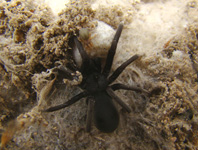Abstract
A new gall-inducing genus and species of felt scales (Hemiptera: Coccoidea: Eriococcidae) found on the leaves and twigs of Matayba guianensis (Sapindaceae) in Brazil is described: Bystracoccus Hodgson gen n. and B. mataybae Hodgson, Isaias & Oliveira sp. n. This is the first record of an eriococcid inducing leaf and stem galls on Sapindaceae and is only the second example of a member of the Eriococcidae to induce stem galls in which the insects diapause during the dry (winter) season. Only the adult female, second-instar female and crawler are known. The species overwinters as the first-instar nymph in pit galls on the twigs but spends the rest of the year associated with two-chambered galls on the leaves. It has recently become clear that South America has a rich felt-scale insect fauna many of which induce galls. It has proved very difficult to place this new genus in a family as it appears to fall between the Eriococcidae and Beesoniidae but is here placed in the eriococcids based on the similarity of the first-instar nymphs and the abundance of this family in the Neotropics. However, the dorsum of the abdomen of the mature adult female becomes heavily sclerotised, forming a round plug-like structure that completely fills the gall orifice. This structure shows remarkable morphological similarities to that of the beesoniid Danumococcus parashoreae Takagi & Hodgson found on Parashorea tomentella (Dipterocarpaceae) in Sabah, Malaysia, with which it is compared along with other eriococcid genera known from South America.

